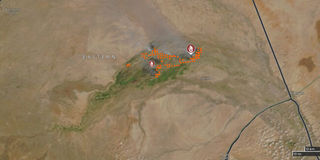Premium
Isiolo wildfires: Satellite images show how inferno spread unabated for a week

What you need to know:
- Raging wildfires in Isiolo have so far destroyed more than 200,000 acres of grazing land.
- Area residents say they have been battling flames for the last seven days in vain.
Inaccessibility of areas where wildfire is raging in Isiolo County and lack of proper equipment has derailed efforts by residents of Basa location, Cherab Sub County to put out another fire that broke out on Thursday.
This, as satellite images by Nasa Worldview Satelite imagery, showed how the inferno spread unabated for over a week.
The wildfires are still devouring swathes of grassland in Isiolo South and Isiolo North constituencies where more than 200,000 acres of pasture land has been destroyed, according to county commissioner Mr Geoffrey Omoding.
Despite deployment of about 200 rangers by the Kenya Forest Service (KFS) in Sericho area on Thursday, members of the local community in Basa were mobilised to contain a fresh fire in the area.
Basa location chief Mr Nuro Sime said the rangers were deployed at Sericho where residents had managed to contain the fire.
“A fresh fire has broken out in my location and I have mobilised at least 40 youths who have gone there to try and contain it. But the flames are so fierce that they cannot manage,” he said.
“The biggest problem is that we don’t have water. The little that is supplied to us by water bowsers is used for domestic use and is brought after every four days. We appeal to the government to deploy more resources and put out the fire before it causes more damage,” Mr Sime said.
The chief spoke even as residents of Sericho recounted how they had, for seven days, fought the raging fire with their bare hands.
On Friday January 17 at around 7pm, Aburo Jarso, the community chairman noticed some red flames light up the sky about 20 kilometres from the shopping centre and sensed danger. The following day, word went round that the pasture the pastoralist community had preserved for two years, was on fire.
This marked seven days of anguish and torment as they mobilised the entire village in an exercise that would test their resilience to the limits.
“The area that caught fire is part of our community forest that we have preserved for two years now. The pasture was to come in handy in the event there is drought,” he said, adding that the thought of this reserve being destroyed sent them into motion.
“When we alerted the authorities, there were some officers from the county who came and listened to our cries but they never came back to help us,” Mr Jarso said.
“We could not sit and watch as the fire approached our village so with no equipment and little experience in fire fighting, we went out to fight the enemy. We could not have allowed it to consume the entire grazing land,” he added.
Mr Jarso discounted the earlier theory about cause of the fire that some herders lit up the pasture with the aim of eliminating ticks, saying that practice was abandoned long time ago.
“These days we spray our livestock with prescribed pesticides and we cannot resort to such outdated methods. We suspect honey gatherers might have been the cause of the fire,” Mr Jarso said.
An official of the Kenya Red Cross who spoke to the media said they had helped the community with essential items such as fuelling vehicles that were ferrying the youth to affected areas and supplying them with food.
“We did the much we could including providing first aid to the few people who were injured as they fought the fire,” said the officer who could not be named as he is not the organisation’s spokesperson.
Mr Allan Ongere, KFS regional forest conservator in charge of Ewaso North Conservancy comprising of Isiolo, Samburu and Marsabit counties said so far there were no deaths of wild or domestic animals reported.
“What has been destroyed are mainly grasslands,” he said.
On Thursday, the Borana Council of Elders expressed dissatisfaction over slow response by the county government of Isiolo in containing the inferno.
“The extent of the damage on the pasture calls for national government attention. It is unfortunate that no one has responded since the fire started,” Borana Council of Elders chairman Mohamed Konso said.
Isiolo County has experienced similar wildfires in the past with the worst happening in 2020 when it devoured a stretch of over 150 kilometres.
After destruction of pastures and rains failed in 2021, this resulted to serious drought in 2022 that claimed lives of thousands of livestock.









